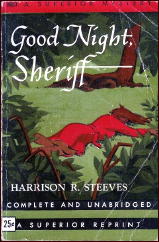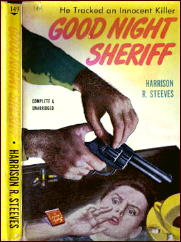Thu 7 Jun 2012
Reviewed by William F. Deeck: HARRISON R. STEEVES – Good Night, Sheriff.
Posted by Steve under Authors , Collecting , Reviews[13] Comments
William F. Deeck
HARRISON R. STEEVES – Good Night, Sheriff. Random House, hardcover, 1941. Mercury Mystery #60, digest paperback, no date, abridged. Superior Reprint M657/The Military Service Publishing Co., paperback, 1945. Note: The Superior paperback was also released with a dust jacket published by Bantam and numbered #149. (See the two cover images below.)

Having graduated from medical examinations for an insurance company to “medical investigator,” Dr. Patterson is asked to read the inquest of the shooting death of Agnes, wife of Dr. Thomas Earlie, who either died by accident or murder.
Patterson notices some oddities in the testimony and goes to the scene, somewhere in New England, to determine whether the beneficiary of Mrs. Earlie’s insurance policy might have murdered her.
Pretending to be merely a physician interested in hunting, Patterson fools nearly no one. All those involved in any way with the death are intent on protecting Dr. Earlie, who did not stand to gain from his wife’s death.
One of Patterson’s conclusions — dismissing a most likely murderer since “temperamentally he couldn’t have done it” — bothered me, but he does in the end spot the culprit through an unusual motive. Or does he?
An only mystery, whose limited action is more than made up for by solid writing and good characterization.

Editorial Notes: There was a lucrative deal between the military in the mid-1940s and Ian Ballantine in which the army furnished the paper and Penguin supplied the books, which were then distributed to the various armed forces. Among the books published this way was the line of “Superior Reprints.” The troops received the books free, but they were available for purchase by the general public as well.
For more on this arrangement, check out the Bookscans website.
When Ballantine left Penguin to start Bantam, he brought some of the Superior paperbacks with him and re-released them with Bantam jackets. The jackets have mostly disappeared over the years, making them extremely collectible. Once the jacket is removed, if there is any way to tell a Superior paperback from one released as a Superior/Bantam hybrid, I do not know. (I have always assumed not.)
As for Harrison Steeves, the author himself, I found the following online at the Golden Age of Detection Wiki:
“Harrison Ross Steeves was born [in 1881] in New York City and educated at Columbia, where he became head of the English department before his retirement in 1947. […] After retirement he lived in New Hampshire. His sole detective work was Good Night, Sheriff (1941).” [According to Crime Fiction IV, by Allen J. Hubin, he died in 1981.]
June 7th, 2012 at 4:59 pm
I always thought Superior Reprints were done by Bantam. Never knew this bit of book publishing history. Thanks for the notes! I find Superior Reprints all the time in my book hunting and assumed that they were all missing their DJs. Now I know otherwise. I should start buying all of those I find now I know how unusual they are.
The only Bantam I have wtih a DJ is DEATH OF A GHOST by Margery Allingham. There are some Bantam books that have DJs that are completely different from the cover of the Superior Reprint edition. I’ve seen a few in my travels. Maybe these are the hybrids. When I get home I’ll report on what exactly is the case with the Allingham book.
June 7th, 2012 at 6:23 pm
John
There are quite a few early Bantam’s with jackets that were Bantam’s and not Superior’s, and as far as I know, there are Superior’s that never came out later with Bantam jackets. Without looking up the exact number, I don’t think there were all that many books in the Superior Reprint series, maybe a couple dozen.
Well, why not look it up? There were only 21, running from M637 to M657, the Steeves book. Why this strange sequence of numbers, I have no idea.
I think (but am not sure) that the Allingham paperback you have in jacket is a Penguin, not a Bantam. It’s #503, 4th printing, pictured here:
http://bookscans.com/Publishers/penguin/penguin1.htm
Let us know more about it when you have it in hand. No matter what, it’s quite scarce. There can’t have been many that survived.
June 7th, 2012 at 8:06 pm
Here is what I believe to be a complete list of the Superior Reprint paperbacks that were published later as Bantam’s with dust jackets:
M642 Philip MacDonald, The Rynox Murder Case — Bantam 144
M646 Ring Lardner, The Love Nest — Bantam 145
M649 Frank Gruber, The Navy Colt — Bantam 151
M650 Liam O’Flaherty, The Informer — Bantam 150
M654 Robert George Dean, On Ice — Bantam 148
M655 Frank Gruber, The Mighty Blockhead — Bantam 144
M656 H. H. Munro, A Saki Sampler — Bantam 143, as The She-Wolf
M657 Harrison R. Steeves, Good Night Sheriff — Bantam 149
June 7th, 2012 at 6:39 pm
Steve:
According to his obituary, he died at his home in Kingston, RI. Jacques Barzun was one of his pupils at Columbia.
Victor Berch
June 7th, 2012 at 7:45 pm
Victor
Barzun was one of his students? Now that’s interesting!
Steve
June 7th, 2012 at 9:51 pm
I have a copy of Good Night, Sheriff. Somewhere many years ago I saw a note of praise for the book and that stuck in my mind so that when I found a copy I bought it. (I’ve not read it, yet.) In looking at it now I see that it is dedicated to nine people who read the manuscript and gave Steeves advice. There is a 10th name on the list, Bennett A. Cerf. Would he have been his editor? He also had a couple of “friendly physicians” advise him on medical matters. The dedication page begins: “This story was written by a tyro in the misguided thought that anyone with everyday literacy can write a mystery story.” According to the blurb on the back cover he was 60 when it was published. His being on the faculty at Columbia explains why one of the people to whom the book is dedicated is Mark Van Doren. Steeves was also a specialist in literary-legal property.
June 7th, 2012 at 10:02 pm
Randy
Bennett Cerf was one of the founders of Random House, who published the hardcover edition, so yes, that’s the connection.
I also note that you use the phrase “I’ve not read it, yet.” Call me a ditto-head, but I have to say the same. But as usual, the odds are higher, now that I’ve read this review, the first I’ve ever read of the book, which I’ve owned for years.
The fact is, though, that Bill Deeck somehow managed to say something interesting about every book he talked about, and he did it again with this one.
— Steve
June 8th, 2012 at 12:06 am
Somehow I missed seeing that Random House was the publisher of the hardcover or I would have known Cerf was his editor. My copy is the Superior Reprint, of course, and I recognized the cover you displayed. If I weren’t still getting the June Dime Novel Round-Up ready for the printer as well as working on a long article for the August issue I might be inclined to start reading the book now.
June 8th, 2012 at 4:00 am
Hey, I reviewed this one late last month and the back cover had some interesting, but summary, information on the author and the book – which was written after Steeves read a few dozen mysteries while recuperating from an unspecified illness.
I would love to know the list of detective stories he had been reading because the book is not without merit, however, it would’ve worked better, IMHO, if the false and actual solutions had been swapped around.
http://moonlight-detective.blogspot.nl/2012/05/heavy-rain.html (see comment section for the part about the solution swap).
June 8th, 2012 at 9:42 am
TomCat
That’s a great review of the book. It’s tough to talk about the ending of a detective novel without giving away anything you shouldn’t, but to me you pulled it off in fine fashion. Matched up with Bill Deeck’s review, it makes me all the more eager to dig out my copy. Something is telling me I should have read it long before now!
— Steve
June 8th, 2012 at 3:22 pm
Steve,
Thanks for the kind words and it’s an interesting detective story, in spite of its imperfections. And it’s always interesting to read an outsiders take on the genre.
April 27th, 2016 at 10:34 am
Some former students of Harrison Steeves:
Clifton Fadiman ’25
Bennett Cerf ’20
Jacques Barzun ’27
All of this found in a letter posted in the Feb. 2000 newsletter of Columbia College (the general liberal arts college and part of the much larger Columbia University) where Steeves taught Englsih for over 40 years. The letter was written by Steeves’ nephew, John Steeves, Class of 1948, who at the time was living in Savannah, GA.
June 30th, 2016 at 8:01 pm
A character depicting Professor Steeves appears in the movie, “Kill Your Darlings,” in which Steeves has a role in the development of Allen Ginsberg when he was a student at Columbia.